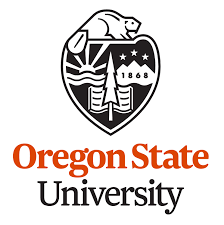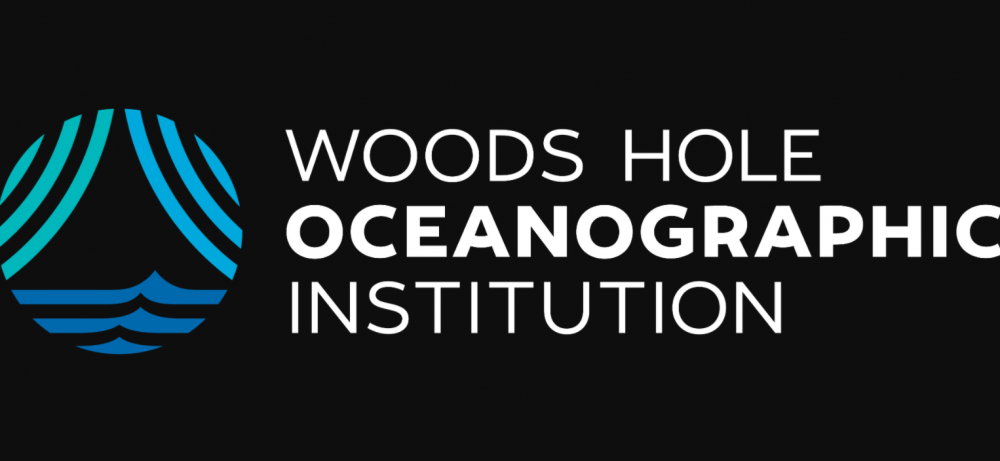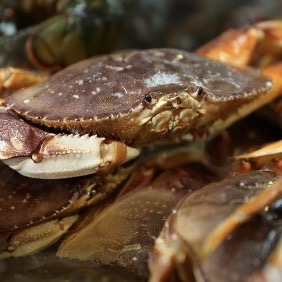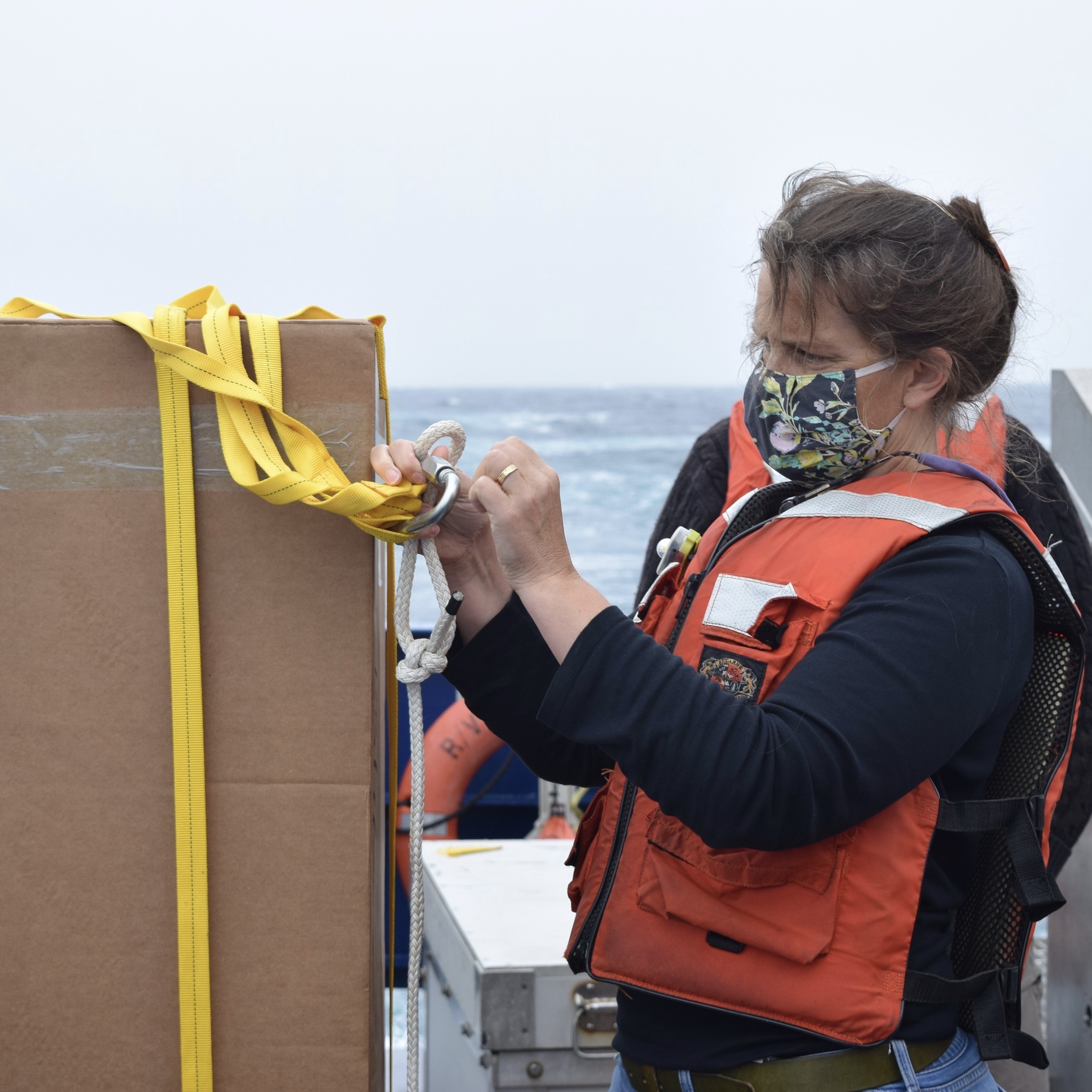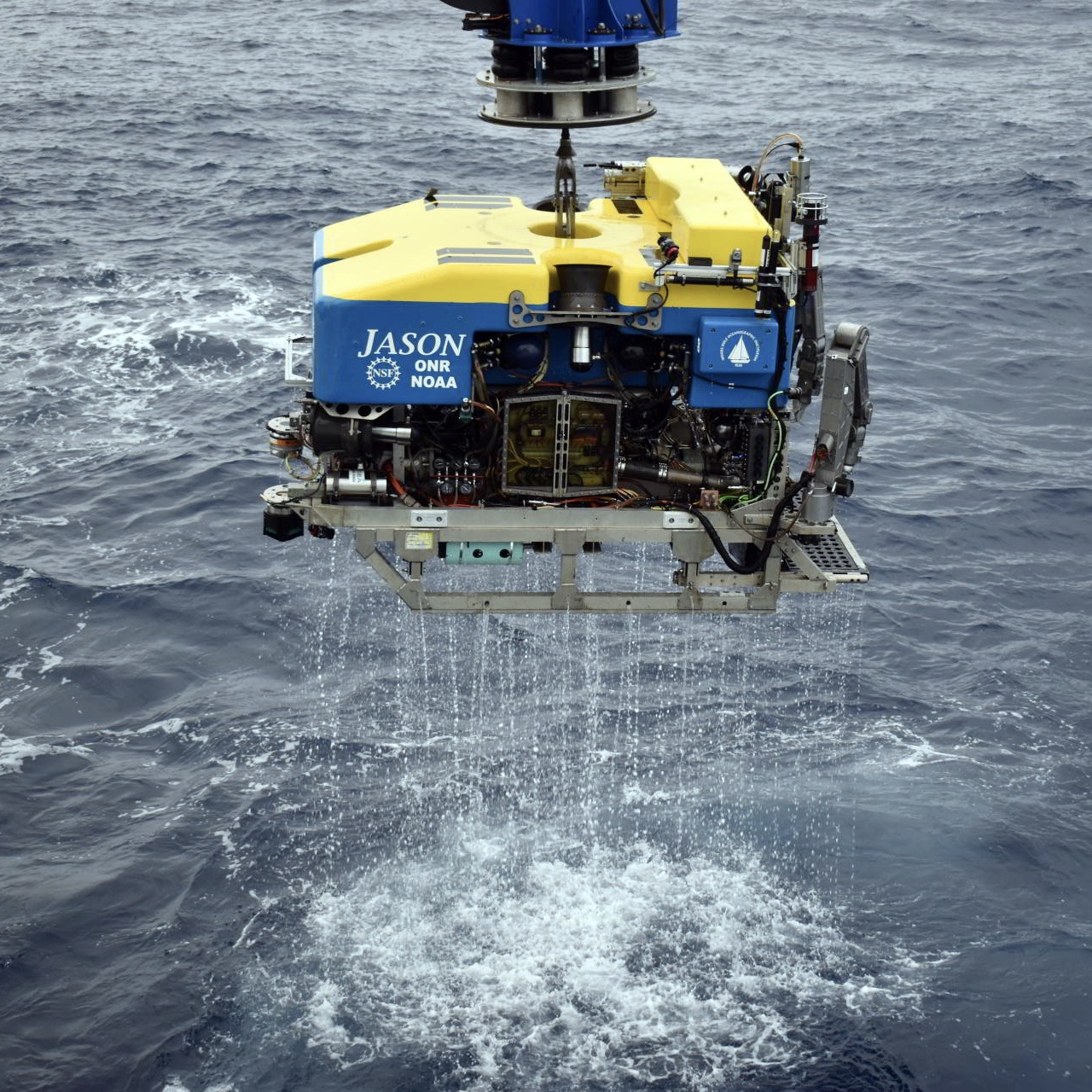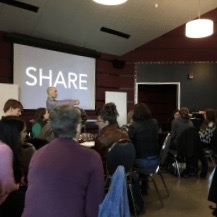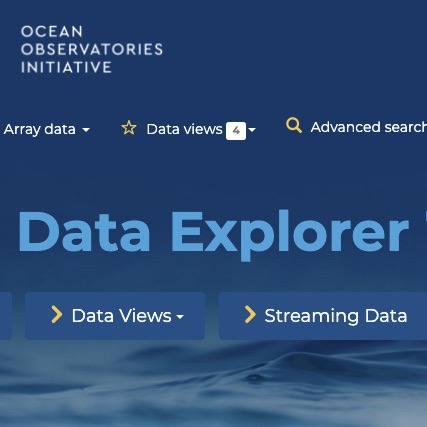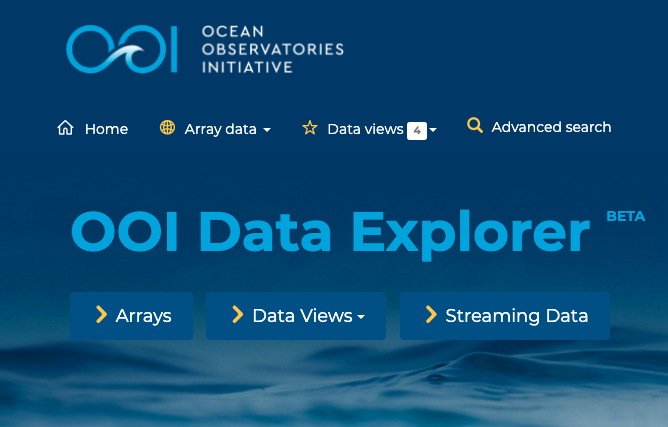News
OSU Assumes Cyberinfrastructure Responsibility for OOI
Woods Hole Oceanographic Institution (WHOI) and Oregon State University (OSU) jointly announced that OSU will assume responsibilities for the systems management of the cyberinfrastructure that makes data transmission for the Ocean Observatories Initiative (OOI) possible through September of 2023. OSU was awarded this role after a systematic and thorough selection process. Rutgers, the State University of New Jersey, has provided OOI’s Cyberinfrastructure systems management since 2014, and will leave the OOI Program in 2021 following a transition period with OSU. The OOI consists of five instrumented observatories in the Atlantic and Pacific Oceans outfitted with more than 900 instruments that continually collect and deliver data to shore via a cyberinfrastructure, which makes the data available to anyone with an Internet connection. The demands on the cyberinfrastructure are great, as it stores 73 billion rows of data, and has provided 36 terabytes of data in response to 189 million user requests since 2014. With the data requests and delivery demands increasing each year, the OOI has the capability to provide data that allows inquiries into episodic ecosystem events in real-time, as well as investigations using long-term time series data. The OOI is made possible through a funded five-year cooperative agreement to WHOI from the National Science Foundation. The OSU award is for $6 million over a three-year period.
“We are delighted that OSU has the capabilities and expertise to take on this hugely important task,” says John Trowbridge, Principal Investigator of the Program Management Office of the OOI at WHOI. “The OOI has become a dependable source of real-time ocean data, helping scientists answer pressing questions about the changing ocean. Educators use real-time ocean data to teach students about the fundamentals of oceanography, the global carbon cycle, climate variability, and other important topics. The team at OSU will help advance this work and ensure that OOI data are served reliably to an ever-growing audience.
“We are also extremely grateful to the Rutgers team for the excellent foundation they established over the past six years that will allow a seamless transition to the OSU cyberinfrastructure team. Rutgers was an important partner that helped establish OOI as a reliable data provider,” adds Trowbridge.
“OSU brings the perfect mix of hardware, software, and ocean data experts to ensure that we are able to store and serve up this gargantuan amount of important ocean data,” adds Anthony Koppers, Principal Investigator for the OSU Cyberinfrastructure Systems Team. “We have the key personnel and systems in place that will allow us to seamlessly take on the challenge of storing and serving OOI data, strategically planning for future data demands and implementing cybersecurity. We also will be working hand-in-hand with the OOI’s Data Management Team to ensure the data meets the highest quality standards.”
OSU’s cyberinfrastructure will handle telemetered, recovered, and streaming data. Telemetered data are delivered to the cyberinfrastructure from moorings and gliders using remote access such as satellites. Recovered data are complete datasets that are retrieved and uploaded to the cyberinfrastructure once an ocean observing platform is recovered from the field. Streaming data are delivered in real time directly from instruments in the field.
Read More
Ocean Data Labs Tutorial at WHOI Available Online
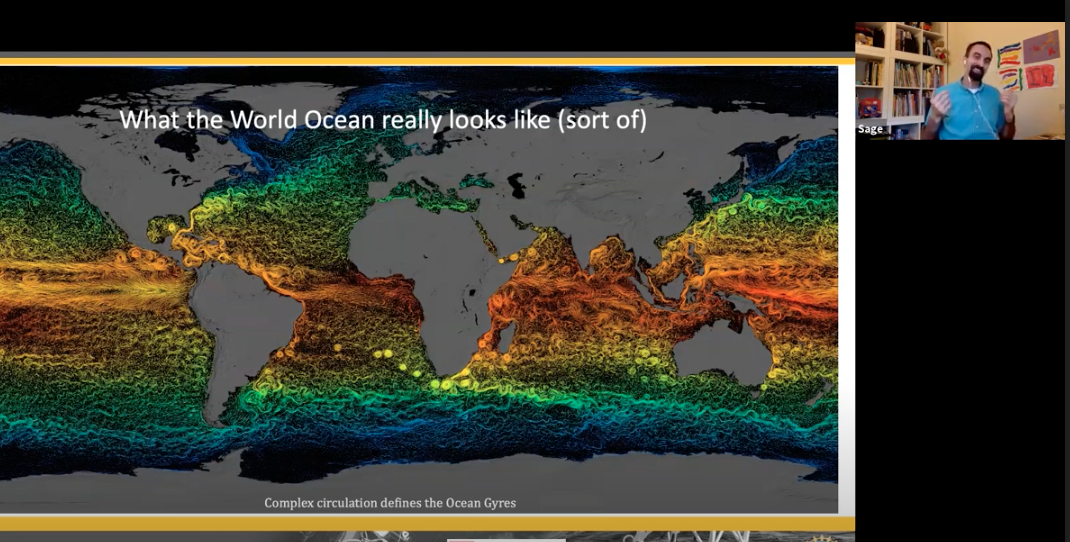 The Zoom screen was full as 40 people participated in the third of Woods Hole Oceanographic Institution’s (WHOI) Data Science Summer Series on 4 August 2020. Research Programmer Dr. Sage Lichtenwalner, of Rutgers, the State University of New Jersey, who helped design and implement the Ocean Observatories Initiative (OOI) Ocean Data Labs, presented.
The Zoom screen was full as 40 people participated in the third of Woods Hole Oceanographic Institution’s (WHOI) Data Science Summer Series on 4 August 2020. Research Programmer Dr. Sage Lichtenwalner, of Rutgers, the State University of New Jersey, who helped design and implement the Ocean Observatories Initiative (OOI) Ocean Data Labs, presented.
Lichtenwalner gave an overview of the many resources available through the Ocean Data Labs project, which is developing, testing, refining, and disseminating easy-to-use, interactive Data Explorations and Data Lab Notebooks for use in the classroom. Entertaining and information, the hour-long presentation flew by as Lichtenwalner presented tricks and tips to downloading OOI data, how to use OOI data in python and other computing platforms such as the Google Colab interface, and ended with a demonstration visualization of OOI data collected by its Pioneer Array. The complete webinar can be viewed here.
Dr. Stace Beaulieu, a senior research specialist in Biology and coordinator of WHOI’s Ocean Informatics Working Group, planned and hosted the session.
Read More
Partnerships Expand Use of OOI Data
The OOI’s primary mission is to make its data widely available to multiple users. One way it achieves this, on a broad scale, is by establishing partnerships with other organizations that also distribute ocean observing data. For example, OOI currently partners with the Integrated Ocean Observing System (IOOS), which provides integrated ocean information in near real-time and tools and forecasts to apply the data, the National Data Buoy Center (NDBC), which maintains a network of data collecting buoys and coastal stations as part of the National Weather Service, the Global Ocean Acidification Observing Network (GOA-ON), which uses international data to document the status and progress of ocean acidification, and Incorporated Research Institutions for Seismology (IRIS), a consortium of over 120 US universities dedicated to the operation of science facilities for the acquisition, management, and distribution of seismological data.
NANOOS: Making data relevant for decision-making
NANOOS, the Northwest Association of Networked Ocean Observing Systems, which is part of IOOS, has been operational since 2003, establishing trusting, collaborative relationships with those who use and collect ocean data in the Pacific Northwest. NANOOS has been an exemplary partner in ingesting and using OOI data. Part of its success lies in advance planning. NANOOS, for example, had determined that OOI assets, in addition to achieving the scientific goals for which they were designed, could fill a data void in IOOS assets running north and south in an area between La Push, WA, and the Columbia River, well before the OOI assets came online.
[media-caption type="image" class="external" path="https://oceanobservatories.org/wp-content/uploads/2020/09/Screen-Shot-2020-09-22-at-2.25.24-PM.png" alt="Endurance Array" link="#"]OOI’s Coastal Endurance Array provides data from the north and south in an important upwelling area in the northeastern Pacific. Gliders also traverse this region, with glider data available through both the IOOS Glider Data Assembly Center and the NANOOS Visualization System. Credit: Center for Environmental Visualization, University of Washington.[/media-caption]According to Jan Newton, NANOOS executive director at the University of Washington, “One of the reasons NANOOS is so effective is that our guiding principle is to be cooperative and not compete. If the public is looking for coastal data, for example, we want to make sure they can access it and use it, rather than having them trying to sort through whether it is a product of IOOS or OOI. We operate with the philosophy of maximizing the discoverability and service of the data and OOI has been a great partner in our mission. We’ve been really happy about how this partnership has played out.”
[media-caption type="image" class="external" path="https://oceanobservatories.org/wp-content/uploads/2020/09/Regional-Cable-Array-revised-.jpg" alt="Revised RCA" link="#"]OOI’s Regional Cabled Array also contributes data in the NANOOS region from its Slope Base and the Southern Hydrate Ridge nodes. Credit: Center for Environmental Visualization, University of Washington.[/media-caption]NANOOS has made a huge effort on its data visualization capabilities, so people can not only find data, but look at it in a relative way to use it for forecasting, modeling, and solving real-world problems. OOI data are integral in helping support some of these visualization and modeling efforts, which commonly play a role in situations facing a wide cross-section of society.
An example of this applicability played out in improved understanding of hypoxia (oxygen-deficient conditions) off the coast of Oregon, which had resulted in mass mortality events of hypoxia-intolerant species of invertebrates and fish, in particular, Dungeness crabs. Allowing access through NANOOS to near real-time oxygen data from OOI assets has allowed the managers and fishers to come up with some plausible solutions to maintaining this valuable resource. The Dungeness crab fishery is the most valuable single-species fishery on the U.S. West Coast, with landed values up to $250 million per year, and plays an enormous cultural role in the lives of tribal communities in the region, as well.
[media-caption type="image" class="external" path="https://oceanobservatories.org/wp-content/uploads/2020/09/Dungeness-Crab.jpg" alt="Dungeness Crab" link="#"]OOI oxygen data have helped resource managers and fishers maintain the valuable Dungeness crab fishery, which is the most valuable single-species fishery on the U.S. West Coast.[/media-caption]Researcher Samantha Siedlecki, University of Connecticut, reports that in late June of 2018, for example, fishers in the region were pulling up dead crabs in pots without knowing the cause. Scientists accessed near real-time OOI observations through the NANOOS data portal and found that the Washington Inshore Surface Mooring of the Coastal Endurance Array (EA) had measured hypoxia from June 7th onwards. So, the data confirmed real-life conditions and explained the crab mortalities.
This is important because such occurrences are helping to confirm models and enhance forecasting to better manage these events by providing guidance to fishers and resource managers. In this instance, the forecast indicates what regions will likely require reduced time for crabs to remain “soaking,” caged in the environment during hypoxia events, to ensure crabs are captured alive, and also aid in spatial management of the fishery itself. OOI data will play a role in continual improvements in forecasting in this region and the fishery by providing data during winter months, ensuring historical data are available and quality controlled for use in forecasting, and continuing to serve data in near real-time.
Adds Newton, “I can’t tell you how many OOI and other PIs come up and tell me how they love that their data are having a connection to real world problems and solutions. It makes their research go farther with greater impact by being part of this NANOOS network.”
Explains Craig Risien, Coastal Endurance Array senior technician at Oregon State University, “OOI is collecting an incredible wealth of data, offering a treasure chest of material to write papers, write proposals, include in posters, and now it is being used in practical ways for finding scientific solutions to environmental problems. Every time we look at the data, there’s a new story to tell. We always find something new, something interesting, and encourage everyone to have a look and experience the same usefulness and excitement about OOI data.”
Sharing OOI data
The OOI is in talks with the IOOS regions serving the Northeast Atlantic and the Mid-Atlantic to see how OOI data might enhance their networks, as well. The OOI also has been providing data to the National Data Buoy Center since 2016, supplementing the data collected by NDBC’s 90 buoys and 60 Coastal Marine Automated Network stations, which collectively provide critical data on unfolding weather conditions. And, the OOI has been providing data to Global Ocean Acidification Observing Network (GOA-ON), since mid-2019, ground-truthing on site conditions in real to near real-time, which is critical to understanding conditions contributing to ocean acidification and improving modeling capabilities to determine when it might occur. OOI’s Regional Cabled Array has been providing seismological, pressure and hydrophone data to Incorporated Research Institutions for Seismology (IRIS) since 2014, providing a wealth of data from Axial Seamount and on the Cascadia Margin. For example, on April 24, 2015 a seismic crisis initiated at the summit of Axial Seamount with >8,000 earthquakes occurring in 24 hrs, marking the start of the eruption. Starting at 08:01 that same day, the network recorded ~ 37,000 impulsive events delineating underwater explosions, many of which were associated with the formation of a 127 meter thick lava flow on the northern rift.
Data examples
If you would like to test drive some of the OOI data in NANOOS, NDBC, and GOA-ON, here are some examples below:
IOOS
· OOI data in the NANOOS Visualization System (NVS)
NDBC
· Coastal Endurance Array data (Stations 46097, 46098, 46099, 46100)
· Coastal Pioneer Array data (Stations 44075, 44076, 44077)
· Global Irminger Array data (Station 44078)
GOA-ON
· Coastal Endurance Array data
IRIS
· Regional Cabled Array (While searching within IRIS for OOI data, use the two-letter IRIS network designator “OO.”)
Read More
Coastal Endurance Array Dissolved Oxygen Webinar Online
If you missed the 16 September 2020 Coastal Endurance Array’s webinar on dissolved oxygen, you can view it below. It’s an easily digestible webinar series in four short sections, detailing the Coastal Endurance Array’s dissolved oxygen data, how they are collected, and what is being learned from this collection of five+ years of data.
https://youtu.be/NlfPH8X5Vy8
https://youtu.be/2uJYzthlvJs
https://youtu.be/aus7eaDlNtE
https://youtu.be/s7f_6rdBf2w
Read MoreBuilding a Community of Practice for OOI Biogeochemical Sensor Datasets
The Ocean Observatories Initiative (OOI) includes sensors that measure key biogeochemical properties (pH, pCO2, bio-optics, nitrate, dissolved oxygen) on both moored and mobile autonomous platforms across arrays in the Atlantic, Pacific and Southern Oceans. These sensors provide enormous potential to support the oceanographic community in studying a wide range of important interdisciplinary questions. However, OOI biogeochemical sensor data have thus far been underutilized by the oceanographic community, as the application of these rich data streams to quantify biogeochemical fluxes and answer many questions of scientific interest (e.g., rates of air-sea CO2 flux, productivity, and export; comparison across sites; monitoring of long-term changes) require effective calibration and validation, including post-deployment human-in-the-loop processing. To broaden the use of OOI biogeochemical sensor data and increase community capacity to produce analysis-ready data products, we have acquired NSF support to bring together scientists with expertise in biogeochemical sensor calibration and analysis from both within and beyond the current OOI user community to develop guidelines and best practices for using OOI biogeochemical sensor data. These recommendations will be collated in a published white paper that will be shared with the broader oceanographic community to build data user capacity and enable new scientific applications of OOI biogeochemical sensor data.
This activity was initially planned as a small workshop in conjunction with the 2021 Ocean Carbon & Biogeochemistry (OCB) summer workshop (June 2021 in Woods Hole, MA). Given the uncertainties related to the pandemic, we would like to identify potentially interested participants early and query their preferred level(s) and mechanism(s) of engagement with this activity to help inform our planning efforts. We anticipate that the development of best practices for different biogeochemical variable sets will require several months of commitment, likely a combination of online engagement and participation in an in-person workshop that will either take place in 2021 or 2022. We envision that members of the oceanographic community may have varied levels of interest in such an activity (e.g., development of detailed OOI sensor data processing guidelines vs. broader scientific applications of OOI biogeochemical data streams). If you have any interest in potentially participating in this activity at any level, please fill out this Google form. Responses received by mid-October are greatly appreciated.
Additional information and questions about this activity can be directed to Hilary Palevsky (palevsky@bc.edu), Sophie Clayton (sclayton@odu.edu), and Heather Benway (hbenway@whoi.edu).
Read More
A Collaborative Month in the Irminger Sea
A team of 10 Woods Hole Oceanographic Institution scientists, who spent the month of August aboard the RV Neil Armstrong, arrived at home port in Woods Hole on 4 September, having successfully skirted Hurricane Laura as she headed in their direction. The bumpy ride home capped the successful deployment of all OOI Irminger Sea Array moorings in sometimes turbulent seas.
While onsite at the array, the team successfully met all of its mission objectives by recovering and deploying four moorings and deploying two gliders. One glider transits the individual moorings, which are spaced approximately 20 km apart, while the second glider samples the upper 200-meters of the ocean above the centrally located hybrid profiler mooring, which measures the remainder of the 2800-m water column. A third glider was recovered soon after deployment because it had a microleak. The team also conducted CTD casts at each of the moorings, which measure onsite temperature, salinity, and oxygen conditions and validate data being collected and sent to shore by the array.
“The Irminger Sea array presents both unique opportunities and challenges for reporting ocean data,“ explained Sebastien Bigorre, who served as chief scientist on the Irminger Seven expedition. “It is located in a remote area of the North Atlantic with high wind and large surface waves, which present operational challenges. The area is also of great interest for scientists and society because of the intense exchange of energy and gases between the atmosphere and the ocean. The ocean there captures heat and carbon dioxide from the atmosphere, thus it is an important component of the climate system. It is also a region of high biological productivity, making it an important fishery. Recent studies have shown that the data collected at the Irminger array are essential to correctly describe the ocean circulation of the North Atlantic.”
It is an eight-day transit from Woods Hole to the Irminger Sea Array and another eight-day transit to return to home port. To maximize the use of ship time, the Irminger Sea Array Team shared ship space and mission time with scientists from OSNAP (Overturning of the Subpolar North Atlantic Program). OSNAP is seeking to provide a continuous record of the horizontal transport of heat, mass, and freshwater in the subpolar North Atlantic, and is complemented by the much longer-term records of water-column properties and air-sea transfer of momentum, heat, and moisture that are provided by the OOI Irminger Sea Array. Once on site, the expedition started with deployment of OOI moorings and gliders, switched its focus to recovery and re-deployment of OSNAP moorings, before finishing with the recovery of the previous year OOI Irminger Sea moorings.
“Our partnership with OSNAP is an example of how we try to maximize our resources for scientific research, from cruise planning, to operations at sea. During transits, we test and triple check our equipment to ensure that comes deployment day, everything goes as smooth as possible. On site, we coordinate operations to accommodate for weather conditions or to optimize shared equipment or personnel. When there is a lull in scientific activities, we plan for the ship’s instrumentation to collect data that is relevant to our scientific objectives, so every hour of the cruise is used to its full potential,” added Bigorre.
The following images show the many tasks undertaken during the month-long expedition:
[media-caption type="image" class="external" path="https://oceanobservatories.org/wp-content/uploads/2020/09/IMG_4208-scaled.jpg" alt="Irminger 7 masks" link="#"]OOI Irminger Sea cruise participants James Kuo (foreground), Jennifer Batryn, and Collin Dobson demonstrate proper social distancing and PPE use on the deck of the R/V Neil Armstrong during departure from the Woods Hole Oceanographic Institution (WHOI) dock Sunday 9 August. Photo credit: Rebecca Travis©Woods Hole Oceanographic Institution.[/media-caption] [media-caption type="image" class="external" path="https://oceanobservatories.org/wp-content/uploads/2020/09/IMG_4215-scaled.jpg" alt="Armstrong awaiting departure" link="#"]The R/V Neil Armstrong is loaded with crew and equipment and ready to depart for the month-long expedition to the Irminger Sea Array. Photo credit: Rebecca Travis©Woods Hole Oceanographic Institution.[/media-caption] [media-caption type="image" class="external" path="https://oceanobservatories.org/wp-content/uploads/2020/09/Screen-Shot-2020-09-14-at-4.56.05-PM.png" alt="Drone overhead" link="#"]A place for everything, everything in its place. Aerial view of the R/V Neil Armstrong deck with equipment loaded for the OOI Irminger Sea Array service cruise. Photo credit: James Kuo©Woods Hole Oceanographic Institution.[/media-caption] [media-caption type="image" class="external" path="https://oceanobservatories.org/wp-content/uploads/2020/09/Glider-with-mask-scaled.jpg" alt="Glider with mask" link="#"]Even the gliders took precautions for the Irminger Sea Expedition! (The tape was removed before deployment). Photo credit: Diana Wickman©Woods Hole Oceanographic Institution .[/media-caption] [media-caption type="image" class="external" path="https://oceanobservatories.org/wp-content/uploads/2020/09/IMG_2081-scaled.jpg" alt="Off stern" link="#"]Global Surface Mooring loaded on the R/V Neil Armstrong deck. It replaced a mooring recovered at the site. Photo credit: James Kuo©Woods Hole Oceanographic Institution.[/media-caption] [media-caption type="image" class="external" path="https://oceanobservatories.org/wp-content/uploads/2020/09/IR7_Dobson_lab-scaled.jpg" alt="Collin in lab" link="#"]Engineer Collin Dobson performs function checks on OOI gliders in the lab of the R/V Neil Armstrong during the transit out to the OOI Irminger Sea array. Photo credit: Jennifer Batryn©Woods Hole Oceanographic Institution.[/media-caption] [media-caption type="image" class="external" path="https://oceanobservatories.org/wp-content/uploads/2020/09/IR7_glider_prep-scaled.jpg" alt="Glider prep" link="#"]Two OOI gliders sit in the lab of the R/V Neil Armstrong during the transit out to the Irminger Sea array. The location of the glider oxygen sensors (blue housings forward of the tail fin) was modified so the sensor is exposed to the air when the glider surfaces. Photo credit:Jennifer Batryn©Woods Hole Oceanographic Institution.[/media-caption] [media-caption type="image" class="external" path="https://oceanobservatories.org/wp-content/uploads/2020/09/20200817_101902.cam3_.jpg" alt="Buoy camera" link="#"]Eyes at sea. This image was captured during the Irminger Global Surface Mooring deployment 17 August 2020 by a camera on the buoy shortly after the buoy was lowered into the water. The camera normally helps operators monitor ice buildup and storm conditions, but on that day it turned its lens on the action aboard the R/V Neil Armstrong. Photo credit: Buoy camera©Woods Hole Oceanographic Institution.[/media-caption] [media-caption type="image" class="external" path="https://oceanobservatories.org/wp-content/uploads/2020/09/SUMOsplice_NicoLlanos_20200811.jpg" alt="Nico splicing" link="#"]Nico Llanos splices lines together, in preparation for the OOI Global Surface Mooring deployment. The surface mooring will be deployed in almost 3,000 m (1.8 mile) of water off of Greenland. Together, the nylon and Colmega add up to almost one mile of rope line, and provide the bottom part of the mooring above its anchor. Photo credit: Heather Furey©Woods Hole Oceanographic Institution .[/media-caption] [media-caption type="image" class="external" path="https://oceanobservatories.org/wp-content/uploads/2020/09/whiteboard_AR46_20200811-1-scaled.jpg" alt="Whiteboard" link="#"]Just like on land, a whiteboard serves as a notice of ongoing and completed activities aboard the R/V Neil Armstrong during the Summer 2020 Irminger Sea month-long expedition. Photo credit: Heather Furey©Woods Hole Oceanographic Institution .[/media-caption] [media-caption type="image" class="external" path="https://oceanobservatories.org/wp-content/uploads/2020/09/IR7_Argo_float.jpeg" alt="Argo float" link="#"]Research Specialist Heather Furey prepares an Argo float for deployment off the stern of the R/V Neil Armstrong. The yellow straps are used to deploy the float while it is still in the box. The cardboard biodegrades in the water and releases the float. Photo credit: Jennifer Batryn©Woods Hole Oceanographic Institution.[/media-caption] [media-caption type="image" class="external" path="https://oceanobservatories.org/wp-content/uploads/2020/09/DSC_0403-scaled.jpg" alt="James Kuo" link="#"]OOI Engineer James Kuo checks the inductive communications on the Irminger Sea Flanking Mooring B during deployment. Most of the instruments on this subsurface mooring transmit data to the mooring controller inductively. The data is then sent acoustically to OOI Gliders which transmit the data to shore via satellite. Photo Credit: Jennifer Batryn©Woods Hole Oceanographic Institution.[/media-caption] [media-caption type="image" class="external" path="https://oceanobservatories.org/wp-content/uploads/2020/09/DSC_0908-1-scaled.jpg" alt="McClane Profiler" link="#"]The OOI team at the Irminger Sea Array deploying the Profiler Mooring. The yellow McLane Moored Profiler with a suite of science instruments is carefully lowered into the water. It will measure water properties including temperature, salinity, fluorescence, dissolved oxygen and water velocity. Photo credit: Jennifer Batryn©Woods Hole Oceanographic Institution.[/media-caption] [media-caption type="image" class="external" path="https://oceanobservatories.org/wp-content/uploads/2020/09/DSC_0012-scaled.jpg" alt="Profiler off stern" link="#"]The OOI Irminger Sea Hybrid Profiler Mooring is deployed top-first and trails behind the ship. Once the ship is at the desired location, the anchor is slid off the back deck, making quite a splash as it falls to the seafloor, pulling the mooring into place. Photo credit: Jennifer Batryn©Woods Hole Oceanographic Institution.[/media-caption] [media-caption type="image" class="external" path="https://oceanobservatories.org/wp-content/uploads/2020/09/Irminger-Sea-Posting--scaled.jpg" alt="Group shot" link="#"]The OOI and OSNAP science team poses on the back deck of the R/V Neil Armstrong on 27 August. 2020, after completing operations at the Irminger Sea Array. Using the last hours of good weather, equipment was secured before the eight-day voyage back to Woods Hole. Photo: Michael Sessa©Woods Hole Oceanographic Institution.[/media-caption] [media-caption type="image" class="external" path="https://oceanobservatories.org/wp-content/uploads/2020/09/northernlights_dobson-scaled.jpeg" alt="Northern lights" link="#"]One of the advantages of going to the OOI Irminger Sea Array is the opportunity to see the northern lights (Aurora borealis).This photo was taken as the team transited home through the Labrador Sea. What a great reward for all of the hard work put in to have a successful cruise! Photo credit: Collin Dobson©Woods Hole Oceanographic Institution.[/media-caption] Read MoreMission Complete: 23 Days at Sea
By Darlene Trew Crist and Debbie Kelley
23 days at sea.1200 miles of transit. 44 ROV Jason Dives. Over 80,000 lbs of equipment mobilized. Turned, deployed or recovered 225 pieces of infrastructure on the seafloor and in the water column. More than 500 hours of continuous livestreaming video from ship to shore through a satellite 22,000 miles overhead, and daily updates of cruise activities.
These numbers provide only a glimpse of what was accomplished by a team of scientists and engineers from the University of Washington (UW), pilots of the ROV Jason from Woods Hole Oceanographic Institution, and the captain and the crew of the R/V Thomas G. Thompson, during a nearly month-long expedition in the northeast Pacific Ocean to maintain OOI’s Regional Cabled Array (RCA), operated and maintained by UW. After a mandatory two-week quarantine, the scientific party departed aboard the R/V Thompson from Newport, Oregon on 1 August to begin the journey to replace and install equipment on the array. The ship returned to Newport on 13 August to offload the recovered equipment and load a new supply for the second Leg, which left on 15 August, finally returning to port on 26 August.
Funded by the National Science Foundation (NSF), the cruise was highly complex, involving a diverse array of ~109 Core instruments, three junction boxes, two Benthic Experiment Platforms, six instrumented pods on the Shallow Profiler Moorings, which were recovered and installed, and three Deep Profiler vehicles, which were turned. In addition, six instruments conducting scientific experiments for principal investigators external to OOI were recovered, one was installed and another turned.
While the overall mission was clear, the cruise plan remained flexible to allow the Chief Scientists to modify operations, as needed, depending upon weather conditions. The expedition traveled to all of the RCA sites — Slope Base, Oregon Offshore, Oregon Shelf, Southern Hydrate Ridge, and Axial Base and Axial Caldera, with multiple 22-hour transits to Axial Seamount.
[media-caption type="image" class="external" path="https://oceanobservatories.org/wp-content/uploads/2020/09/Regional-Cabled-Array.-.jpg" alt="Regional Cabled Array" link="#"]Location of RCA infrastructure showing installed backbone cable (solid lines), extension opportunities (dashed lines) Primary Nodes (red boxes), cabled moorings (green dots), and Endurance uncabled moorings (yellow dots). Credit: University of Washington.[/media-caption]All Objectives Completed on Leg One
All instrument and platform installations scheduled for Leg 1 were completed by mid-day on 12 August during 26 dives. Six instrumented platforms on the Shallow Profiler Moorings and three instrumented Deep Profiler vehicles were turned, two junction boxes and over 80 instruments recovered and reinstalled.
Taking advantage of the good weather and the early completion of anticipated tasks, the RCA team transited to the Endurance Shelf site (80 meters), where they recovered several cabled platforms and instruments that were planned for Leg 2 of the expedition. Again, taking advantage of ideal visibility at the seafloor there, the RCA team performed three Jason dives, successfully recovering the Zooplankton Sonar, the Benthic Experiment Package (BEP), and a digital still camera.
After the completion of these dives, the R/V Thomas G.Thompson headed back to shore. The ship arrived at the NOAA Marine Operations Center-Pacific dock in Newport, Oregon on 13 August and began mobilization/demobilization for the changeover from Leg 1 to Leg 2 of the cruise.
[media-caption type="image" class="external" path="https://oceanobservatories.org/wp-content/uploads/2020/09/Combined-picture-RCA.jpg" alt="Combined picture" link="#"]Deploying the new Deep Profiler vehicle at Slope Base on 11 August (left) Credit: M. Elend, University of Washington, V20.; Recovering the Benthic Experiment Package (BEP) at the Endurance Shelf site (right): Credit: UW/NSF-OOI/WHOI.V20.[/media-caption] [media-caption type="image" class="external" path="https://oceanobservatories.org/wp-content/uploads/2020/09/Combined-2.jpg" alt="Combined 2" link="#"]R/V Thomas G. Thompson, Leg 1 Demobilization / Leg 2 Mobilization of two BEPs, a Zooplankton sonar platform, and platforms to be installed at Axial Seamount Credit: University of Washington, V20.[/media-caption]Weather Challenges on Leg Two
The ship departed from Newport again on 15 August and headed to the Endurance Array Oregon Shelf site to resume maintenance operations. There, the team deployed the cabled Zooplankton Sonar, however, installation of the BEP, which weighs over 3,000 lbs and is latched underneath Jason for installation and recovery, was postponed due to large swells.
The ship next transited over 300 miles offshore to Axial Seamount to complete the maintenance activities there. When the Thompson arrived at Axial, it successfully turned a secondary node at the Eastern Caldera site that provides power and bandwidth to a geophysical suite of instruments and now hosts a new CTD funded by NSF to Dr. W. Chadwick (one of three instruments for installation on the RCA as part of this award). It was a notable event because the junction box had been deployed on 22 July 2013 and had spent the last 2,583 days or 7.1 years in 1516 meters of water within Axial Caldera!
For the next eight days, cruise operations proceeded smoothly with intermittent weather delays. Even though weather was not completely cooperative, the team was able to complete a total of 14 dives during which they turned a BEP, two digital still cameras, two uncabled seafloor instruments, and a CTD. They also recovered three cabled instruments and an uncabled instrumented platform for principal investigators conducting research at Southern Hydrate Ridge. One dive was dedicated to an inspection and troubleshooting of Primary Node PN1B, which was offline.
Later in the cruise, weather put onboard activities on hold, however, a cohort of enthusiastic students onshore (due to COVID) virtually ‘visited’ the ship and Jason operations van as part of the NSF-funded STEMSEAS program, which provides at-sea experiences for undergraduates. The students had the opportunity to interact with Chief Scientist Brendan Philip, who completed his oceanography undergraduate and masters’ degree at the University of Washington, as well as a visit with two UW and Queens College undergraduate students sailing onboard as science aides as part of the UW VISIONS experiential learning program. They were also introduced to RCA engineers and members of the Jason team inside the control van.
[media-caption type="image" class="external" path="https://oceanobservatories.org/wp-content/uploads/2020/09/Katie_Steve_sm.Newport_20200815_111023_L2_start-copy-2-scaled.jpg" alt="Katie_Steve" link="#"]K. Gonzalez, UW Oceanography undergraduate, and S. Karaduzovic, Queens College undergraduate, gaze out into the NE Pacific as the R/V Thomas G. Thompson sails through the Yaquina Bay channel on its way to begin Leg 2 of the RCA expedition. Credit. M. Elend, University of Washington. V20.[/media-caption] [media-caption type="image" class="external" path="https://oceanobservatories.org/wp-content/uploads/2020/09/J1267_20200809_155656_THSPHA301_deploy-copy.jpg" alt="Screen" link="#"]Video, sonar, and navigation panels inside the ROV Jason control van as the team works nearly a mile beneath the oceans’ surface at the International District Hydrothermal Field atop Axial Seamount. Credit: University of Washington. V20.[/media-caption]With lessening swell heights, the team completed RCA maintenance tasks at Southern Hydrate Ridge. Additional efforts were focused on the recovery of a cabled multi-beam sonar and a 4K camera funded by Germany to Drs. Y. Marcon and G. Bohrmann, Bremen University, to quantify methane flux and turning of a CTD. In addition, a methane microbial fuel cell platform was recovered as part of an Office of Naval Research (ONR)-funded project to Dr. C. Reimers (Oregon State University)—sailing as a member of the Leg 2 shipboard party. Upon completion of instrumentation work at Southern Hydrate Ridge, the Thompson transited back to the Endurance Array Oregon Shelf site to complete the remaining maintenance task, the deployment of the cabled BEP.
During the latter part of the cruise, weather again impacted what the team was able to do, but the science team continued to improvise to utilize ship time as efficiently as possible. For example, when winds (>20 knots) and large swells in the Shelf Area prevented the team from deploying the final (heavy) BEP, Dr. Reimers used some of her remaining ONR-supported at-sea time to conduct a Jason dive in the region of the West Coast Rockfish Conservation Area to survey fish, invertebrates, seeps, and trawl marks along a downslope transect. These data will be useful for collaborative work between Oregon State University and the Oregon Department of Fish and Wildlife scientists in decision-making about the reopening of the region in 2020, after 19 years of being closed to bottom trawling.
When the weather cleared, the team performed its final maintenance task of the cruise. They deployed the cabled Shelf BEP in 80 meters of water, after which the ship headed back to Newport to reunite with friends and family after six weeks away. The expedition ended having met all objectives, in spite of the weather.
Unique Views of the Seafloor
The RCA expedition literally offered a “bird’s eye view” of seafloor life. Below is a collection of some of the activities conducted and life witnessed on the seafloor.
Crab-infested Primary Node
[media-caption type="image" class="external" path="https://oceanobservatories.org/wp-content/uploads/2020/09/News_Crabs_PN1B-use-sulis2_20200818202445--scaled.jpg" alt="News_Crabs" link="#"]The ROVJason inspects Primary Node PN1B. These 12,000 lb nodes and primary backbone cable were built and installed in 2014 through an award to L3MariPro. This large seafloor substation converts 10,000 volts to 374 volts, and 10 Gb/s bandwidth to be distributed to cabled platforms and instruments. Here, extension cables plugged inside the node with wet-mate connectors provide power and bandwidth to Southern Hydrate Ridge, and upstream to the Oregon Offshore and Shelf sites. Credit: UW/NSF-OOI/WHOI. V20.[/media-caption]Octopus Abound
[media-caption type="image" class="external" path="https://oceanobservatories.org/wp-content/uploads/2020/09/Octopus-on-the-seafloor.jpg" alt="Octopus on the seafloor" link="#"]Octopus on the seafloor at Endurance Array Oregon Offshore Site. Credit: UW/NSF-OOI/WHOI. V20.[/media-caption]Islands of Sea Life
[media-caption type="image" class="external" path="https://oceanobservatories.org/wp-content/uploads/2020/09/news_SHllow-Profier_Offshore_20200803_133613180.framegrab03-copy.jpg" alt="Shallow_Profiler" link="#"]The ROV Jason installs a refurbished instrumented platform onto the Shallow Profiler Mooring at the cabled Oregon Offshore site. The platform hosts a zooplankton sonar, and instruments that measure pH, dissolved CO2, salinity, temperature, and dissolved oxygen. The 12 ft-across large mooring platforms at 200 m depth stay in the water for several years and become islands inhabited by a wealth of sea life. Credit: UW/NSF-OOI/WHOI.V20.[/media-caption]Big Red
[media-caption type="image" class="external" path="https://oceanobservatories.org/wp-content/uploads/2020/09/Big_Red_Jelly_sm.sulis2_20200817205124-copy-2-scaled.jpg" alt="Big Red Jellyfish" link="#"]A “Big Red” jellyfish swam past the ROV Jason 68 miles offshore of Oregon. Credit; UW/NSF-OOI/WHOI.V20.[/media-caption]Methane Seeps
[media-caption type="image" class="external" path="https://oceanobservatories.org/wp-content/uploads/2020/09/News_Abundant-Life-SHR_good_sulis2_20200826014741-copy-2-scaled.jpg" alt="Abundant_Sea_Life" link="#"]The Regional Cabled Array team always enjoys dives to the methane seep site at the Southern Hydrate Ridge. It is rich in animals — e.g. red striped rockfish, lavender hagfish, crabs, spotted sole — that thrive among the carbonate blocks and adjacent to the seeps where methane streams from the seafloor. Credit: UW/NSF-OOI/WHOI.V20.[/media-caption]Axial Seamount Summit
[media-caption type="image" class="external" path="https://oceanobservatories.org/wp-content/uploads/2020/09/News_use_J2-1277_Great-Crab-collapse_sulis2_20200817132525-copy-scaled.jpg" alt="Spider Crab" link="#"]A spider crab explores a collapsed, frozen lava lake at the summit of Axial Seamount, an active underwater volcano 4970 ft beneath the oceans’ surface, which is poised to soon erupt. Credit: UW/NSF-OOI/WHOI.V20.[/media-caption]
Read More
Ocean Data Labs Webinar 16 September
On 16 September at 4 pm Eastern, Ocean Data Labs will kick off it fall webinar series: Ocean Data Labs Plus, a webinar series for Community College and University Professors teaching oceanography or geosciences courses. The series opener will be “New You Can Use,” hosted by the OOI Data Labs Project Team and special guests.
The webinar will explore how the Data Labs Project can support your efforts to introduce big data into your undergraduate courses. Join the Team to find out about newly-developed interactive online data-focused activities that are grounded in learning science – and consider how to effectively incorporate them into your courses. Check out the Ocean Data Lab’s online collection of data explorations and data nuggets in advance, and bring your questions and ideas. Each webinar will last about 60-75 minutes and is meant to be more of an interactive discussion.
Register: https://rutgers.zoom.us/meeting/register/tJApfuGoqjItGtbfEBMLQFf9MNkZTDCVGUdp
Read More
Shedding Light on Wave Energy Harvesting
Two entrepreneurs and two engineers recently teamed up to develop a wave-based energy generator with the potential of powering the Pioneer Array, while also providing energy to a new, longer lasting, and potentially more effective way to keep the array’s sensors free and clear.
The Department of Energy thought the idea had such potential that it awarded the team a Small Business Technology Transfer (STTR) grant that will allow them to develop a proof of concept of this system by late March 2021.
The development team consists of grant Co-Investigator Matt Palanza, program engineer for the Ocean Observatories Initiative (OOI) at Woods Hole Oceanographic Institution (WHOI), Megan Carroll, a research engineer at WHOI and expert in the dynamics of moored systems, and Principle Investigator Julie Fouquet and Co-Investigator Milan Minsky, principals of 3newable, LLC, a firm dedicated to the development of small-scale wave energy converters. Fouquet started by developing and testing wave energy converter concepts on land, to choose an efficient, low-cost and flexible approach. Minsky brings to the team extensive experience in developing first-generation ultraviolet LEDs for medical and industrial applications that she will put to good use in designing a system to tackle serious biofouling conditions that plague all equipment put into the ocean for extended periods.
“The concept of harnessing wave energy at the Pioneer Array, then powering an ultraviolet LED anti-fouling light, which could possibly keep the array functioning much longer, would be a win-win. If this combination is proven here, it could have widespread application in oceanographic research and aquaculture applications, with tremendous potential for cost savings,” said Palanza.
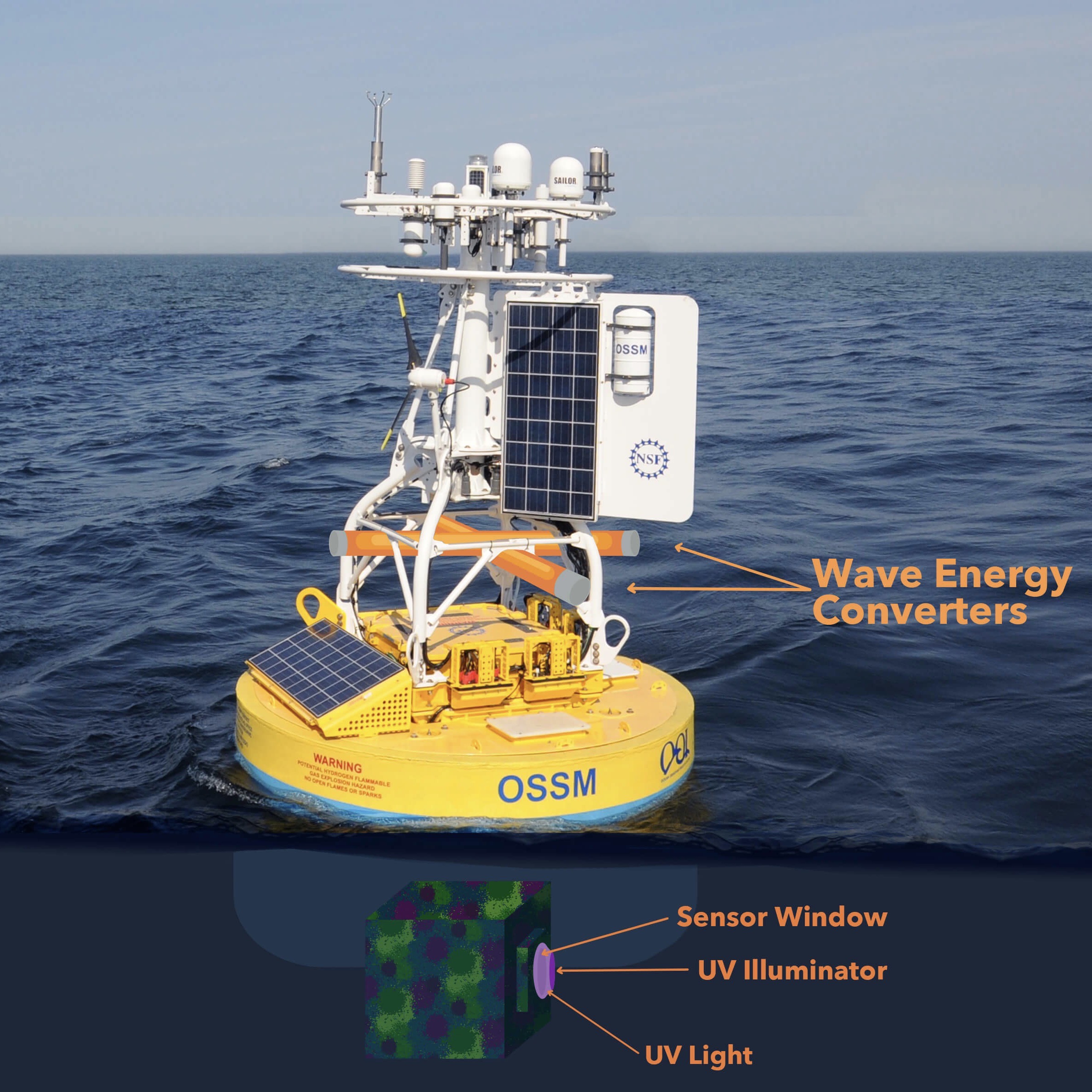 Striving for Good Environmental Outcomes
Striving for Good Environmental Outcomes
Julie Fouquet founded 3newable LLC in 2015 with the goal of capturing electrical power from water waves as a source of renewable power. Previously, companies wanting to commercialize wave energy generation had failed while attempting to build utility scale systems, which were extremely costly. Years of experience in the semiconductor industry taught Fouquet that product development requires multiple design-build-test-redesign cycles. Companies developing utility-scale systems ran out of money before reaching a viable product. She chose to focus her efforts on developing an efficient and cost-effective small-scale wave energy converter that could fit into the back of an SUV and on a runabout boat.
Having worked together for decades, she and Minsky – now vice president of product at 3newable – teamed up to find out what sort of applications in the oceanographic community could use a small-scale wave energy converter.
After many meetings, they concluded that the Pioneer Array buoys would be a good testing ground. Palanza agreed and the team set out to write a proposal that would capitalize on their collective talents to provide a potential real-world application of wave energy and anti-biofouling technology.
The Pioneer Array buoys are already powered by wind and solar, but the wave energy converter offers a way to keep the sensors clear and recording for longer time periods using UV LED lights, possibly extending trip intervals needed to service the arrays.
Like most things in spring 2020, COVID caused delays in the launch of this project. DOE announced the award in May, but the actual award was delayed until early August, which potentially squeezes the March deadline for producing the feasibility study. From there, the team hopes to move forward to Phase 2, which would involve construction of both the wave energy conversion and UV anti-fouling prototypes and testing in the field.
“We are already working in a distributed way with processes in place so COVID hasn’t impacted our progress in analyzing data and developing lab tests,“ said Minsky. “But the interesting thing about the pandemic is that it has really propelled the UV LED field along as people explore its potential medical uses. Prices are dropping and quality is going up so we will be able to take advantage of these advances as we go about commercializing this module.”
During Phase 1, the team will be striving to answer the following questions:
· How much power is needed to run UV anti-biofouling equipment at the array?
· Can enough power be generated to meet the demand?
· How big of a wave energy converter unit will be needed?
· What are the unit size limitations if attached to the array?
“We all are excited to get this project launched. There’s a real need for improved anti-biofouling technology, and with the emergence of UV LEDs powered by waves onsite, it’s a sound solution with a potentially positive environmental impact, “added Palanza.
Read More
New Data Explorer Tool Coming Online in October
To help make OOI data more accessible, useable, and easily integrated into research and classrooms, the OOI data team has spent the last year developing a new tool that will allow users to discover the data required to meet their needs. The new “Data Explorer” has been undergoing user testing for the past three months and will be ready for broad distribution in early October.
Data Explorer will allow users to search and download cabled, uncabled, and recovered data, compare datasets across regions and disciplines, generate and share custom data views, and download full data sets using ERDDAP.
“We are really excited about the launch of Data Explorer version 1,” explained Jeffrey Glatstein, head of OOI’s cyberinfrastructure, who guided a team of data and visualization experts in developing the tool. “It is an excellent tool that offers a variety of ways for researchers, educators – and others interested in ocean observations—to use OOI data to answer their ocean observation data questions. What we’ve learned over the test period is that additional refinements will be needed, but we first want input from the community, to help identify and prioritize the most important ones. Subsequent versions will build upon this first release to make the Data Explorer the primary tool to explore OOI data.”
Data Explorer contains physical, chemical, geological, and biological ocean observation data collected in near real time. Glatstein and the OOI Data Team worked with Axiom Data Science to develop a system that is both powerful yet user friendly.
Stay tuned. The launch is set for the beginning of October 2020.
Read More

